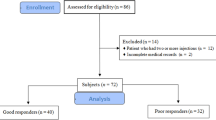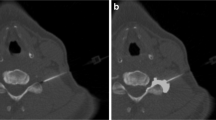Abstract
Objective
To verify the usefulness of a fluoroscopy guided cervical interlaminar epidural steroid injection (CIESI) in patients with neck pain and cervical radiculopathy and to evaluate outcome predictors.
Design
We retrospectively analyzed 91 patients from July 2004 to June 2005 in whom CIESI was initially performed for neck pain and cervical radiculopathy. Therapeutic effects were evaluated 2 weeks after the administration of CIESI, and CIESI effectiveness was graded using a five-point scale, namely, whether the pain had disappeared, was much improved, slightly improved, the same, or aggravated. We also used a visual analog scale (VAS) for the clinical evaluation. According to documentation and follow-up charts, we categorized treatments as effective or ineffective. Possible outcome predictors, namely, diagnosis (spinal stenosis vs herniated disc), primary symptoms (neck pain vs radiculopathy vs both), age, gender, and duration of pain (more or less than 6 months) were also analyzed. Fisher’s exact test, the chi-square test, and multiple logistic regression analysis were used for the statistical analysis.
Patients
After their medical records had been reviewed, 76 patients were included in this study. Inclusion criteria were: the availability of a cross-sectional image, such as a CT scan or an MR image, and a follow-up record after injection.
Results and conclusions
The medical records of 76 patients (male:female = 41 : 35) of mean age 53.1 years (range 32 years to 82 years) were reviewed. Two weeks after injection, 55 patients (72.4%) had experienced effective pain relief. Patients with herniated discs had significantly better results than patients with spinal stenosis (86.1% vs 60.0%) (P < 0.05). Other non-significant predictors of an improved outcome included: a symptom duration of <6 months, a young age, and the presence of cervical radiculopathy. Multiple regression analysis showed that the only factor that was significantly associated with outcome was the cause of the pain, i.e., herniated disc or spinal stenosis. Fluoroscopy guided CIESI is a safe and effective means of treating patients with neck pain and cervical radiculopathy. The most important outcome predictor was cause of pain, and patients with herniated disc experienced better pain relief than those with spinal stenosis.


Similar content being viewed by others
References
Cicala RS, Thoni K, Angel JJ. Long-term results of cervical epidural steroid injections. Clin J Pain 1989;5: 143–145.
Ferrante FM, Wilson SP, Iacobo C, Orav EJ, Rocco AG, Lipson S. Clinical classification as a predictor of therapeutic outcome after cervical epidural steroid injection. Spine 1993;18: 730–736.
Rowlingson JC, Kirschenbaum LP. Epidural analgesic techniques in the management of cervical pain. Anesth Analg 1986;65: 938–942.
Botwin KP, Castellanos R, Rao S et al. Complications of fluoroscopically guided interlaminar cervical epidural injections. Arch Phys Med Rehabil 2003;84: 627–633.
Stojanovic MP, Vu TN, Caneris O, Slezak J, Cohen SP, Sang CN. The role of fluoroscopy in cervical epidural steroid injections: an analysis of contrast dispersal patterns. Spine 2002;27: 509–514.
Johnson BA, Schellhas KP, Pollei SR. Epidurography and therapeutic epidural injections: technical considerations and experience with 5334 cases. AJNR Am J Neuroradiol 1999;20: 697–705.
Silbergleit R, Mehta BA, Sanders WP, Talati SJ. Imaging-guided injection techniques with fluoroscopy and CT for spinal pain management. Radiographics 2001;21: 927–939.
Pfirrmann CW, Oberholzer PA, Zanetti M et al. Selective nerve root blocks for the treatment of sciatica: evaluation of injection site and effectiveness—a study with patients and cadavers. Radiology 2001;221: 704–711.
Jamison RN, VadeBoncouer T, Ferrante FM. Low back pain patients unresponsive to an epidural steroid injection: identifying predictive factors. Clin J Pain 1991;7: 311–317.
Sontag MJ. A theoretical overview of the diagnosis and management of low back pain: acute vs chronic pain and the mind/body continuum. In: Cole AJ, Herring SA, editors. The low back pain handbook: a guide for the practicing clinician. 2nd ed. Philadelphia, PA: Hanley & Belfus; 1993; 39–48.
Abram SE. Treatment of lumbosacral radiculopathy with epidural steroids. Anesthesiology 1999;91: 1937–1941.
Rivest C, Katz JN, Ferrante FM, Jamison RN. Effects of epidural steroid injection on pain due to lumbar spinal stenosis or herniated disks: a prospective study. Arthritis Care Res 1998;11: 291–297.
Gooding MR. Pathogenesis of myelopathy in cervical spondylosis. Lancet 1974;2: 1180–1181.
Johansson A, Hao J, Sjolund B. Local corticosteroid application blocks transmission in normal nociceptive C-fibres. Acta Anaesthesiol Scand 1990;34: 335–338.
Olmarker K, Rydevik B, Nordborg C. Autologous nucleus pulposus induces neurophysiologic and histologic changes in porcine cauda equina nerve roots. Spine 1993;18: 1425–1432.
Olmarker K, Byrod G, Cornefjord M, Nordborg C, Rydevik B. Effects of methylprednisolone on nucleus pulposus-induced nerve root injury. Spine 1994;19: 1803–1808.
Saal JA, Saal JS, Herzog RJ. The natural history of lumbar intervertebral disc extrusions treated nonoperatively. Spine 1990;15: 683–686.
Sizer PS, Phelps V, Matthijs O. Pain generators of the lumbar spine. Pain Pract 2001;3: 255–273.
Bogduk N. Clinical anatomy of the lumbar spine and sacrum. New York: Churchill Livingstone, 1997.
Scuderi GJ, Brusovamik VG, Greg Anderson D et al. Cytokine assay of the epidural space lavage in patients with lumbar intervertebral disk herniation and radiculopathy. J Spinal Disord Tech 2006;19: 266–269.
Winnie AP, Hartman JT, Meyers HL et al. Pain clinic II: intradural and extradural corticosteroids for sciatica. Anesth Analg 1972;51: 990–1003.
Ludwig MA, Burns SP. Spinal cord infarction following cervical transforaminal epidural injection: a case report. Spine 2005;30: E266–E268.
Rathmell JP, Aprill C, Bogduk N. Cervical transforaminal injection of steroids. Anesthesiology 2004;100: 1595–1600.
Furman MB, Giovanniello MT, O’Brien EM. Incidence of intravascular penetration in transforaminal cervical epidural steroid injections. Spine 2003;28: 21–25.
Tiso RL, Cutler T, Catania JA, Whalen K. Adverse central nervous system sequelae after selective transforaminal block: the role of corticosteroids. Spine J 2004;4: 468–474.
Huang RC, Shapiro GS, Lim M, Sandhu HS, Lutz GE, Herzog RJ. Cervical epidural abscess after epidural steroid injection. Spine 2004;29: E7–E9.
Author information
Authors and Affiliations
Corresponding author
Rights and permissions
About this article
Cite this article
Kwon, J.W., Lee, J.W., Kim, S.H. et al. Cervical interlaminar epidural steroid injection for neck pain and cervical radiculopathy: effect and prognostic factors. Skeletal Radiol 36, 431–436 (2007). https://doi.org/10.1007/s00256-006-0258-2
Received:
Revised:
Accepted:
Published:
Issue Date:
DOI: https://doi.org/10.1007/s00256-006-0258-2




